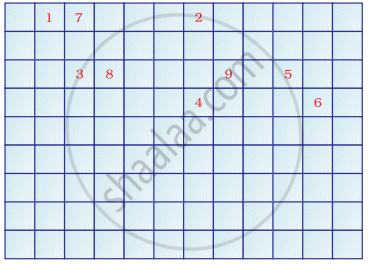Advertisements
Advertisements
प्रश्न
Atoms of eight elements A, B, C, D, E, F, G and H have the same number of electron shells but different number of electrons in their outermost shells. It was found that elements A and G combine to form an ionic compound. This ionic compound is added in a small amount to almost all vegetables and dishes during cooking. Oxides of elements A and B are basis in nature while those of elements E and F acidic. The oxide of element D is, however, almost neutral. Based on the above information, answer the following questions:
(a) To which group or period of the periodic table do these elements belong?
(b) What would be the nature of compound formed by a combination of elements B and F?
(c) Which two of these elements could definitely be metals?
(d) Which one of the eight elements is most likely to be found in gaseous state at room temperature?
(e) If the number of electrons in the outermost shell of elements C and G be 3 and 7 respectively, write formula of the compound formed by the combination of C and G.
उत्तर
(a) The elements belong to the third period of the periodic table, and have the same number of electron shells but different number of electrons in their outermost shells. The number of valence electrons in these elements increases from 1 to 8, on moving from left to right in this period.
(b) When metal B combines with a non-metal F, an ionic compound is formed due to the transfer of electrons from the metal to the non-metal. This is because in the third period, elements A, B and C are metals, D is a metalliod, and E, F, G and H are non-metals.
(c) A and B are definitely metals because in the 3rd period, at the extreme left, only metals are placed in the periodic table .
(d) The element H is most likely to be found in a gaseous state at room temperature. This is because the last group elements in the periodic table are all in a gaseous state at room tempearture.
(e) If the number of valence electrons of element C is 3 and those of element G is 7, then 1 atom of element C will combine with 3 atoms of element G to form a compound with the formula CG3.
संबंधित प्रश्न
An element X from group 2 reacts with element Y from group 16 of the periodic table.
(a) What is the formula of the compound formed?
(b) What is the nature of bond in the compound formed?
A metal X is in the first group of the periodic table. What will be the formula of its oxide?
The non-metal A is an important constituent of our food and most of the fuels around us. A forms two oxides B and C. The oxide B is poisonous whereas oxide C causes global warming.
(a) Identify A, B and C.
(b) To which group of periodic table does A belong?
(c) Name another element which is placed in the same group as A.
A non-metal X which is the largest constituent of air combines with hydrogen when heated in the presence of iron as catalyst to form a gas Y. When gas Y is treated with sulphuric acid, it forms a compound Z which is used as a chemical fertiliser.
(a) What are X, Y and Z?
(b) To which group of periodic table does X belong?
(c) Name the periodic table in which X is placed.
(d) Which element is placed just before X in the period?
(e) Which element is placed just after X in the period?
Classify the following elements into Metals and Nonmetals.
S, Mg, Al, P, N, Na.
Which of the following hydroxides is most basic?
Complete the following cross word puzzle
Across:
(1) An element with atomic number 12.
(3) Metal used in making cans and member of Group 14.
(4) A lustrous non-metal which has 7 electrons in its outermost shell.
Down:
(2) Highly reactive and soft metal which imparts yellow colour when subjected to flame and is kept in kerosene.
(5) The first element of second Period
(6) An element which is used in making fluorescent bulbs and is second member of Group 18 in the Modern Periodic Table
(7) A radioactive element which is the last member of halogen family.
(8) Metal which is an important constituent of steel and forms rust when exposed to moist air.
(9) The first metalloid in Modern Periodic Table whose fibres are used in making bullet-proof vests

Relate the names of the following scientists with the statements given below.
Arranged elements into groups containing three elements each.
Complete the following table:
| Symbol | Atomic No | Electronic Configuration | |
| 1. | He | 2 | ______ |
| 2. | Ne | ______ | 2,8 |
| 3. | Ar | ______ | 2, 8,8 |
| 4. | Na | 11 | ______ |
Element 'X' forms an oxide with the formula X2O3 which is a solid with high melting point. ‘X’ would most likely be placed in the group of the Periodic Table as:
